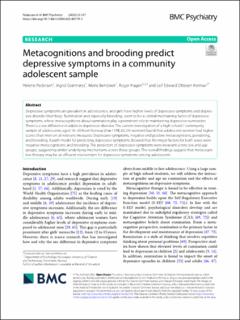| dc.contributor.author | Pedersen, Helene | |
| dc.contributor.author | Grønnæss, Ingrid Hildisch | |
| dc.contributor.author | Bendixen, Mons | |
| dc.contributor.author | Hagen, Roger | |
| dc.contributor.author | Kennair, Leif Edward Ottesen | |
| dc.date.accessioned | 2023-02-21T15:23:39Z | |
| dc.date.available | 2023-02-21T15:23:39Z | |
| dc.date.created | 2022-03-21T14:48:05Z | |
| dc.date.issued | 2022 | |
| dc.identifier.issn | 1471-244X | |
| dc.identifier.uri | https://hdl.handle.net/11250/3052864 | |
| dc.description.abstract | Depressive symptoms are prevelant in adolescence, and girls have higher levels of depressive symptoms and depressive disorder than boys. Rumination and especially brooding, seem to be a central maintaining factor of depressive symptoms, where metacognitions about rumination play a prominent role in maitaining depressive rumination. There is a sex difference in adults in depressive disorder. The current investigation of a high school/community sample of adolescents aged 16-20 from Norway (N=1198, 62.2% women) found that adolescent women had higher scores than men on all relevant measures: Depressive symptoms, negative and postitive metacognitions, pondering, and brooding. A path model for predicting depressive symptoms showed that the major factors for both sexes were negative metacognitions and brooding. The predictors of depressive symptoms were invariant across sex and age groups, suggesting similar underlying mechanisms across these groups. The overall findings suggest that metacognitive therapy may be an efficient intervention for depressive symptoms among adolescents. | en_US |
| dc.description.abstract | Metacognitions and brooding predict depressive symptoms in a community adolescent sample | en_US |
| dc.language.iso | eng | en_US |
| dc.publisher | BioMed Central | en_US |
| dc.rights | Navngivelse 4.0 Internasjonal | * |
| dc.rights.uri | http://creativecommons.org/licenses/by/4.0/deed.no | * |
| dc.title | Metacognitions and brooding predict depressive symptoms in a community adolescent sample | en_US |
| dc.title.alternative | Metacognitions and brooding predict depressive symptoms in a community adolescent sample | en_US |
| dc.type | Peer reviewed | en_US |
| dc.type | Journal article | en_US |
| dc.description.version | publishedVersion | en_US |
| dc.source.volume | 22 | en_US |
| dc.source.journal | BMC Psychiatry | en_US |
| dc.source.issue | 157 | en_US |
| dc.identifier.doi | 10.1186/s12888-022-03779-5 | |
| dc.identifier.cristin | 2011446 | |
| cristin.ispublished | true | |
| cristin.fulltext | original | |
| cristin.qualitycode | 2 | |

